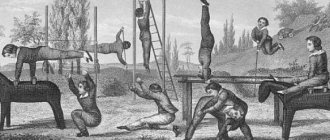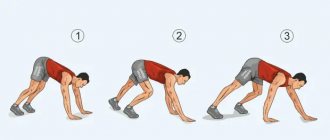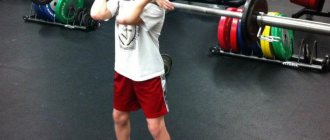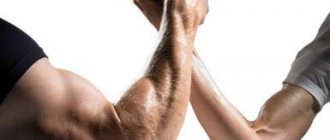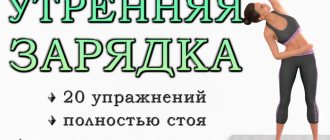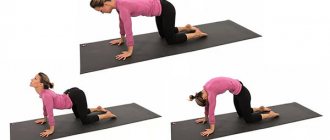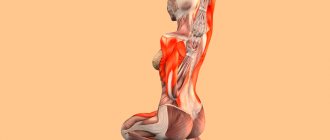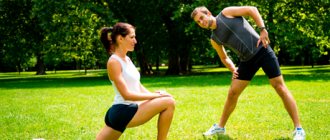Gymnastics is a system of special physical exercises that are designed to improve motor skills, as well as general health promotion. Regular exercise helps develop muscle mass, improve the functioning of the respiratory system, increase the flexibility of the musculoskeletal system, and strengthen cardiac activity.
Gymnastic exercises amaze with their diversity and accessibility. They are suitable for people of all ages and fitness levels. Thanks to this, you can choose the optimal set of workouts for yourself and engage in such activity anywhere at a convenient time. Let's talk about what gymnastic exercises for children and adults exist.
The need for gymnastics
Gymnastic exercises, performed together with a group or individually, are not just one of the fashionable trends in fitness. The benefits of gymnastics today have been scientifically proven, and on the Internet there are more and more videos and photos of gymnastic exercises performed, in particular, by older people.
Thus, they show by their own example that this is a huge health benefit at any age.
What exactly happens to those who pay attention to gymnastic exercises:
- their metabolism accelerates, which helps to lose excess weight;
- immunity is stimulated, as a result of which a person is less likely to get sick;
- the brain is unloaded, efficiency increases - many doctors recommend calm training to combat stress, depression, fatigue, because during exercise the level of serotonin and dopamine (the so-called joy hormones) increases;
- blood circulation and pressure are normalized, blood vessels are strengthened, libido increases;
- sleep returns to normal;
- The lymphatic drainage system is stimulated, making it easier to get rid of toxins and harmful accumulations.
It is important to listen to the advice of a trainer, learn the correct technique for performing movements, and be sure to include stretching in a set of gymnastic exercises.
What are the benefits of gymnastics?
Pediatricians recommend performing the first physical exercises with children from the 2nd week of life. Thanks to movement, the child gets acquainted with the world around him and the capabilities of his body.
TOP 8 beneficial properties of gymnastic exercises for a child can be presented as follows:
- Full physical development , mastering the necessary motor skills. As a result, the muscles of the whole body are strengthened and coordination of movements is formed.
- Development of gross and fine motor skills. Physical exercise improves sensory perception of information.
- Comprehensive healing of the body. Exercises have a beneficial effect on the formation of strong immunity, the development of the central nervous system, cardiovascular and respiratory systems.
- Intellectual and emotional formation. Gymnastics gives children a lot of new interesting information and vivid impressions.
- Formation of logic, thinking, strengthening memory. During training, the child remembers new exercises and comprehends them.
- Full, healthy sleep as a result of physical activity and gaining a lot of new positive impressions.
- If classes are held at home , a big plus is interaction with parents, which has a beneficial effect on the psycho-emotional state of children.
- When performing exercises in a group of peers, socialization skills develop. The child learns to adapt to large groups and meet new people.
Gymnastics directions
There are several types of gymnastics. Each option provides the opportunity to achieve the goal as quickly and efficiently as possible.
Therefore, you should first familiarize yourself with the available areas and choose the most suitable one for yourself in order to get not only the desired result, but also pleasure from the training process itself.
Leg-split
Twine is useful for various elements, for example, for stands or flips, wheels, rands.
First you need to do a warm-up - warm up your neck, back, groins. Then you need to do preparatory exercises - we sit on our legs so that one is bent and the other is straight so that the thigh touches the calf, the angle should be 130 - 140 degrees. Then we begin to smoothly move from side to side. It will be difficult at first, so spread out the exercise over several days.
Make the exercise more difficult - do rolls with the body turning. Sit like this for about 15 seconds on one leg, then on the other. Then start making folds to the side. If you do the exercise for several days, the groins will stretch. There is no need to be afraid of pain, it is stretched muscles, or as athletes say, sore throat. After a while, start doing real splits.
What dangers await beginners? You may pull your groin and get a lingering feeling of pain. There will be pain even when you learn to do the splits - for example, after a long break or without proper warm-up.
There is also a danger of muscle rupture in the groin area; the symptom is the inability to walk, it is difficult to move the leg. This problem can occur due to sudden movements, so train smoothly.
General
For whom: for those who do not care about records or outstanding results. For people with problems with the heart and blood vessels, as well as with the musculoskeletal system.
- Goal: develop physical capabilities, improve health, increase muscle tone.
- Complex: consists of basic fitness exercises that do not injure tendons and joints.
Additional information: used to awaken the body from sleep and restore vigor, to prepare for serious loads (warming up muscles, developing ligaments, accelerating blood, improving joint mobility).
Benefits and types of training
Regular activity will help you stay in excellent physical shape. The main feature of gymnastic exercises is that they have an excellent tonic and training effect. Such exercises speed up metabolism, develop flexibility and mobility of joints, strengthen and tone muscle mass, without overloading the body on a physical level.
Performing gymnastic exercises has a great effect on the functioning of all internal organs. As a result of exercise, the body's energy reserves are activated, blood circulation is stimulated, and the activity of the human respiratory and nervous systems develops and improves. Gymnastics will help you get a boost of energy in the morning, and in the evening it will relieve stress and psychological tension after a hard day.
According to the structure of motor activity, health-improving gymnastic exercises are:
- general developmental;
- tonic or rhythmic;
- athletic;
- medicinal.
When creating your own training set, choose those elements that will help you achieve your goal from playing sports. For example, regular general developmental gymnastics improves physical fitness and has a healing effect. You can increase muscle tone and endurance with the help of athletic elements. Rhythmic activity promotes weight loss, improves physical fitness and endurance, and gives an excellent boost of energy. Therapeutic gymnastic exercises will help correct posture and restore flexibility and mobility of joints. Let's talk about each type in more detail.
Reinforced
For whom: for experienced athletes working on their figure.
- Goal: creating additional resistance for muscles, building muscle, burning fat deposits, tightening and improving body contours.
- Complex: includes several stages.
- Warm-up (prepares the body for stress, warms up muscles and joints with cardio exercises).
- Strength – directly performing gymnastic exercises, while beginners can only use their own weight to begin with.
- Stretching is a stretching exercise that helps maintain elasticity and strength.
Additional information: CrossFit is one of the areas of strength gymnastics, with high dynamics of exercises.
General developmental children's gymnastics
Gymnastic exercises for beginners should be selected based on the following principles:
- Exercises must correspond to the purpose of the complex.
- The complex must be designed so that it affects all muscle groups, ensuring the comprehensive physical development of those involved.
- Exercises must be appropriate for the age, gender and physical fitness of the children.
Methods of teaching gymnastic exercises vary depending on the age of the children. In the 1st year of life, classes are conducted with the help of an adult. By the end of the year, the child's independence increases. He begins to perform some of the exercises by leaning on objects. At this age, it is important to interestingly and vividly depict the action that needs to be done, to support the baby with a word and a smile.
In primary and secondary preschool age, teaching exercise techniques is accompanied by:
- By showing.
- Imitation.
- Visual and auditory techniques.
- Verbal guidelines.
In senior and preparatory groups, classes are often held in a competitive form. Verbal commands and explanations take on a greater role. Demonstration of exercises fades into the background; instead, various visual aids (posters, photographs, videos) are used.
Art direction
For whom: for women and girls who want to discover their potential. Initial training doesn't matter.
- Goal: improving flexibility, coordination, developing a sense of rhythm, strengthening muscles, getting rid of fat deposits.
- Complex: in addition to basic exercises, it includes work with objects (ribbons, balls, clubs, etc.).
Additional information: despite the firmly established association with rhythmic gymnastics as a purely female sport, more and more men are paying attention to this fitness area.
Bridge
The bridge is useful for other gymnastic exercises, for example, a tempo flip. The bridge is used not only in sports and rhythmic gymnastics, but also in acrobatics and complex choreography.
The bridge requires a different warm-up than other elements. The back is an important part of a person, so you need to be careful with it.
Warm-up:
- First, we sit down, straighten our legs and pull on our socks, bend our hands towards our legs. This is necessary so that the back is more stretched.
- Then we lie on our back and raise our arms and legs at the same time, hold it for 10 - 15 seconds. This exercise will help pump up your back.
- We lie on our backs and raise our arms and legs, and then lower them, this is also an exercise to strengthen the back muscles. These muscles are responsible for lowering and raising the body when doing a bridge from the legs.
Making a bridge:
- We lie on our backs, pull our feet to the pelvis, place our hands near our heads with our fingers facing our feet and straighten up.
- After this exercise, continue at the wall - stand with your back to the wall, a distance of about one meter and smoothly lower yourself so that your hands walk along the wall. We also rise smoothly after our hands touch the floor.
- After the back is sufficiently stretched, we make a bridge without a wall.
Place something soft under your head and back, maybe a blanket or a large pillow, or maybe a gymnastics mat.
Possible injuries - you can strain your back on the bridge if you don't warm up or do the exercise too abruptly. The back muscles can hurt for a long time and severely, because there are about five hundred of them.
Acrobatic techniques
For whom: for everyone. It is advisable to have at least a basic level of training to understand and correctly perform basic movements.
- Goal: creative development along with improved physical fitness.
- Complex: in addition to individual exercises, it includes collective work. There is a study of dance steps, steps, jumps, etc.
Additional information: acrobatics itself is variable, which allows you to choose a specific direction. In addition, you can exercise for yourself, or you can aim to conquer the heights of sports.
Exercises with a gymnastic roller
A gymnastic roller is an effective sports equipment. Regular training perfectly works the muscles of the upper shoulder girdle, back muscles, abs, and legs. Simple at first glance, gymnastic elements give a colossal load on almost the entire body.
Consider exercises with a gymnastic roller:
- Stretching. We kneel down and hold the roller in front of us. As you exhale, we begin to roll the projectile forward until the chest touches the knees, and as we inhale, we return back.
- Abdominal and oblique abdominal muscle training. We stand on our knees, holding the roller in front of us. As you exhale, roll the projectile away from you, lowering your chest to the floor as much as possible, but without touching it. As we inhale, we come back. We make three movement options: straight, right, left.
- Working out the core muscles. We lie down on our stomach, our arms with the roller are extended in front of us, with our toes resting on the floor. As you inhale, pull the roller towards you, bending at the lower back, and as you exhale, return to the starting point.
The number of approaches is determined based on your current physical form. If you are just starting to train, then perform 1-2 sets of 15-20 times. In the future, it is recommended to increase the intensity of the load to the maximum, increasing the number of repetitions and approaches. By devoting 20-30 minutes a day to such activities, you will significantly improve your physical fitness.
Rules for gymnastics
There are several of them, and you need to learn the basic requirements by heart.
- Under no circumstances should you argue with the coach, violate the training regimen, or the rules for performing exercises - these are safety precautions. Its violation can be not just harmful, but extremely dangerous.
- A good trainer is the key to effective, interesting and safe training. The choice of trainer should be approached carefully.
- People who have problems with weight should remember: first, weight is normalized, joint mobility is improved, muscles are worked out, and only after that you can begin to learn gymnastic elements.
- Training should be periodic; the cycle cannot be disrupted. Moreover: the higher the goal, the more time you should spend in the gym.
If you have injuries or health problems, you should first consult a doctor and be sure to notify the coach. Without this knowledge, it is impossible to develop a competent individual complex.
It is imperative to combine gymnastic exercises and stretching. And not just at the end of the lesson, but as a separate workout - stretching helps to develop flexibility and relieve stress. Elastic muscles and ligaments are able to work with greater amplitude; accordingly, more exercises can be mastered.
Start of classes
It is best to practice at a sports school or sports club under the supervision of a coach or instructor. This saves a lot of effort on finding training methods. But the simplest gymnastic exercises can be done at home. If you need good results in the future, it is advisable to start training from childhood; sports schools accept gymnasts from the age of four to five. The sooner you start, the easier it will be to master difficult exercises.
But simpler gymnastic complexes can be performed at any age. You just need to find a free half an hour several times a week, preferably three times, and study every other day. If you exercise less often, there will be no result, as muscle tone and stretching will disappear. Buy an exercise mat and clothes that won't restrict your movement. To get a good result, you need to follow an easy diet, especially since gymnastics is good for losing weight. To successfully burn fat, you need to run or jump rope for ten minutes before class. Exercises in classes should be done in such a way as to load problem areas. Before training, you can eat protein foods (cottage cheese, eggs, chicken), while doing exercises you can drink clean water, and after exercising, it is better to wait at least two hours to eat.
Basic rules of classes:
- You need to do a warm-up - warm up your neck, joints, back with the help of rotating and inclined exercises. Please note that cold muscles are easily injured.
- In addition to stretching, do a flexibility warm-up, this is also important.
- Do the exercises without a break; it is better to limit the time of execution than to take breaks. This increases physical endurance.
- You can do squats, push-ups, and lunges only after simpler exercises; you can complicate the program only a month after the start of classes. Don't expect quick results.
About the frequency of classes
There is an opinion that if you practice every day, the result will be achieved faster.
However, this is misleading:
- When doing gymnastics, all the muscles are seriously loaded, and it takes some time to recover;
- In strength gymnastics the loads are so severe that the body regularly receives microtraumas, and regeneration takes time, otherwise the muscles will not form;
- Too high intensity of exercise is a direct path to nervous breakdowns, insomnia, and metabolic disorders;
- Excessive stress causes the tissues of blood vessels and the heart to wear out and become thinner.
You should listen to your own feelings - if, three times after training, the pain in the muscles has not decreased, then the level for the exercises was set too high. It is necessary to consult with a trainer and follow his recommendations.
Useful tips for children and parents
Gymnastic exercises for beginners will be perceived by children with great interest and will have a greater healing effect if the following recommendations are followed.
For example:
- Warm-up at the beginning of classes and the final stage are mandatory components of gymnastics, which in no case should be ignored. If the muscles and joints are not warmed up enough, performing exercises can cause discomfort and lead to injury.
- The child should enjoy the activities. If some action is unpleasant for him or causes significant pain, he should not insist on further performing the exercise.
- It is important to use your imagination and diversify exercises so that children always enjoy the activities.
- It is recommended to use interesting comparisons when explaining the exercise, for example, with animals, birds, and various objects.
- Classes should be conducted every 15-20 minutes. after getting up, before eating.
- In the warm season, it is advisable to charge outside, away from roads.
- It is very important to ensure that children do the exercises correctly. If some action is performed incorrectly, you need to help the child by guiding him or postponing the study to a later date.
- Until the child turns 2 years old, stretching exercises should not be introduced into the training program.
- The exercises are performed starting with the simplest ones and moving on to more complex elements.
- The ideal end to morning exercises would be water treatments or rubdowns.
A well-planned program of gymnastic exercises for beginners has a beneficial effect on the growing body. It gives impetus to harmonious physical development. In order for gymnastics to bring exceptional benefits, it is necessary to take into account the child’s age, his preferences and level of health.
Author: Olga Lavrova
Magic gymnastics
This complex contains various types of gymnastic exercises that help to cheer up after sleep and improve the health of the body.
- Lying in bed, you need to stretch your arms towards the ceiling and begin to quickly rotate your hands - first inward, then outward. Ten times.
- Continue rotations, but now bend your elbows. Also ten times.
- Do the same rotations with your feet - ten times.
- Sitting on the bed, place your feet on the floor - tilt your head left and right, down and back, and also turn your head left and right. Calmly, without jerking, ten times.
- Standing, feet shoulder-width apart. Turn the body left and right, with completely relaxed arms, which, when turning, seem to “overwhelm” the body. Ten times.
- Standing on your right leg, raise your left leg, bent at the knee, so that your thigh is parallel to the floor (heron pose). Pull out the sock. Stretch your left hand forward, right hand down. Stand in balance for ten seconds, close your eyes and stand for another ten seconds. Open your eyes, rise onto your toes three or four times. Do the same with your left leg.
- Sitting on the floor, pull your knees to your chest and clasp your arms. The back is rounded as much as possible. You need to lean back, roll on your back, and sit back down. Do not unclench your hands during the rental. The exercise resembles a “bun”, helps strengthen the spine and relieve fatigue. Ten reps.
- Lying on your back, stretch your arms behind your head, straighten your legs and pull up your socks. Strongly stretch your body from your fingertips to your toes. Hold for at least ten seconds.
- Lying on your back, raise your legs up, while you need to stretch them as high as possible, lifting your lower back off the floor and supporting it with your hands. Hold the “birch” for at least fifteen seconds.
- Lying on your stomach, place your palms on the floor under your shoulders. Resting your hands on the floor, carefully lift your body, arching your back. Do not lift your hips off the floor, straighten your legs and slightly spread them apart, while keeping your heels so that they look up or inward - towards each other. At the highest point, freeze for a couple of seconds and return to the starting position. Repeat ten times.
- Sit on your knees, press your tailbone to your heels, lower your body to your bent legs and try to press your stomach and chest against them. Stretch your arms forward, relax your neck, and lower your head. Round your back, pulling your lower back up for a couple of seconds, relax. Repeat ten times.
- Standing, legs wide, arms open to the sides, palms at shoulder level. Do alternating tilts left and right, holding the extreme position for 2-3 seconds. Do ten repetitions.
- The starting position is the same, lean forward, moving your hands down to the floor. If possible, you should rest your hands on the floor, or at least reach with your fingertips. Hold for 2-3 seconds, return to the starting position.
Having learned this basic complex, you can do some exercises with a gymnastic stick, gradually adding new movements and combinations.
This will allow you to create your own base of effective gymnastic exercises that raise your tone and help you stay in shape.
Simple tricks
Warm up your body with exercises that you like - run, squat, jump from bent knees. It is important to do movements that accelerate blood circulation, which means prepare the heart for stronger loads, so-called cardio exercises. Then proceed to the simplest tricks, which can already be considered gymnastic.
- When standing on an acrobatic bridge, you stretch your back. You need to lie on the floor, bending your knees, your soles should be on the floor, your fingers should be turned towards your feet. Then stretch your back up. You can learn to make a bridge against a wall, slowly sliding down with your hands. But the goal is to do this exercise from a standing position. Stretch your back gradually, as it is quite possible to injure your back with excessive stress. Before the exercise, do a warm-up for your back - bending while standing to the sides, forward and backward.
- Gradually stretch, trying to do the splits. For beginners, it is better to start with forward lunges; you should try to touch the ground with the fingers of your outstretched arms. Then try to do a longitudinal split - place your feet shoulder-width apart, then lean towards the leg that will be in front and thus pull your leg forward and your body down. You can ask someone to help pull your leg and provide backup. For comfort, choose a soft surface, such as a carpet. Then extend your back leg, create tension in your hips, and sway slightly. There is no need to do it with force, as injury is possible; there should be no pain. First, you can lean on the chair with your hand. It’s better to do it little by little, but often and every day; the twine can be achieved even after six months of daily work. Over time, learn to do cross splits.
- Learn to do a handstand. Of course, it’s unlikely that you’ll succeed quickly without support, but against a wall is a pretty good exercise for beginners. The stand is the path to cartwheels, somersaults and other gymnastic acrobatics exercises. You need to spread your legs a little, place your hands at a palm's distance from the wall and quickly raise your legs. The exercise will work out exactly as much as your coordination is developed and the muscles of your arms and body are developed. Frequent repetition will bring results.
- Do jumping jacks on the trampoline - bend your legs under you, legs apart like on a cross split, in a bent position - like a fold on the floor. The vestibular apparatus develops, and stretching improves in the air. Don't overdo it, the trampoline is a dangerous projectile. It is also recommended for beginners to do simple exercises on a balance beam - squats, swings, for balance.
Photos of gymnastic exercises
Exercises with a gymnastic bench
General developmental exercises using a bench train balance, sense of equilibrium, and improve coordination. This projectile can be used not only to develop the vestibular apparatus, but also to develop strength and endurance. By regularly performing various exercises on a gymnastic bench, you will quickly achieve good physical results.
Use this apparatus as a jumping bar, push-up support, or leg raise to work the major muscle groups in your body. Walking with different steps (side-step, cross-step, on toes) perfectly develops a sense of balance. If you play sports with a partner, then organize a small joint fight while standing on a gymnastics bench. This will help you not only diversify your workout, but also give a good load on all muscle groups.
General developmental gymnastics for children
Active outdoor activities strengthen the baby’s respiratory and cardiovascular systems, help improve immunity, and strengthen the child’s body. Regular training will help your child develop well physically. When choosing types of activity from a wide arsenal of general developmental gymnastics for children, pay attention to the balance of the load.
It is recommended to include in the program:
- gymnastic exercises for the back, promoting the formation of correct posture;
- dance elements that help develop plasticity and a sense of rhythm;
- acrobatic exercises that improve flexibility;
- cardio training to increase endurance;
- game elements to develop concentration and focus.
A varied gymnastics program is the key to the full development of your baby on a physical and psychological level. If you have the opportunity, study with your child. Then you will show by your own example that physical education is an important part of life, which should be given maximum attention.
Rhythmic gymnastics for weight loss
Rhythmic gymnastics is a great way to improve physical fitness, get rid of extra pounds, and activate the functioning of the whole body. Regular exercise to energetic music combined with dietary nutrition will give you a slim figure and a wonderful boost of energy. By performing gymnastic exercises for weight loss 3-4 times a week for 30-45 minutes, you will get rid of excess weight, increase muscle tone, and improve your body shape.
The training complex should include a warm-up, exercises for different muscle groups, stretching accompanied by musical accompaniment, which will set the desired pace of intensity. Any physical exercise with an aerobic effect, such as step or dance moves to energetic music, is suitable as a warm-up. The main part is gymnastic training for problem areas at a moderate pace: squats, walking in place, cycling, leg swings, raising the body, working with dumbbells. Stretches while listening to relaxing music.
Exercises on the horizontal bar
Pull-ups on the bar with external assistance - i.e. the parent holds the child by the stomach and helps him pull himself up. Gradually reduce assistance. It is important that when doing pull-ups, the child maintains a straight body position, does not bend his legs and pulls himself up to the chin (i.e., the chin is higher than the bar). Perform: 2 sets of 10 times.
Emphasis on straight arms on a low crossbar - these can also be parallel bars. Starting position: standing on the crossbar with straight arms, shoulders slightly forward, back rounded, emphasis on hips, legs together. Perform 2 sets of 10-20 seconds.
Moving with your hands on a hanging bar - find any long, high bars, stairs (there are many of these on playgrounds) where the child can hang on his hands and move in different directions without the help of his legs.
Technique of gymnastic exercises and the patterns underlying it
Many exercises in sports, rhythmic gymnastics and acrobatics have a very complex structure, both in content and form, and, consequently, in execution technique.
Structure
gymnastic exercise includes content, form, interaction of external and internal forces that ensure the execution of the exercise.
Content
exercise is a set of movements included in it, the sequence of their implementation and the gymnast’s abilities necessary for this. In the process of mastering an exercise, these properties enter into active interaction, ensuring the fulfillment of the motor task set by the gymnast or his teacher. It shapes and changes the structure of the exercise.
Form
A gymnastic exercise is formed by the positions and movements of the gymnast’s body and its links in space and time, the relationship between the gymnast’s abilities. The form is closely related to the content of the exercise.
A distinction is made between the technique of a gymnastic exercise and the technique of performing a gymnastic exercise.
Gymnastic exercise technique
is an objective model of the structure of movements (sample, standard) both in content and form. It is developed on the basis of quantitative and qualitative biomechanical analysis of the structure of movements, its morphological, biochemical, physiological and psychological support. This is a very complex dynamic functional system. In it, individual properties (abilities) related to all substructures of the gymnast’s personality are involved in functional interaction.
Technique for performing gymnastic exercises
is an expedient method or set of methods for controlling movements that ensure the successful completion of an exercise or the solution of a specific motor task.
The following types of exercise techniques are distinguished:
a) exemplary - ensuring impeccable performance of exercises close to technique in wrestling conditions;
b) rational, or individual - reflects (takes into account) the constitutional, motor, functional, psychological characteristics of the gymnast and his experience.
The performance of exercises in gymnastics must meet the requirements of its inherent style. It has objective and subjective
ny character. Objective
the nature of the performance depends on the model, sample, standard of the structure of the exercise technique, and
the subjective nature depends
on the individual way of performing the exercise, on how accurately the gymnast reproduces the technique of the gymnastic exercise and expresses himself in the movements. The technical skill of gymnasts is characterized by the stability and quality of execution of the exercise.
The technique of gymnastic exercises is based on the laws of mechanics, anatomical, physiological and psychological properties of the gymnast’s personality. The laws of mechanics explain how individual links and the body as a whole move in a gymnast’s movements under the influence of external and internal forces. Anatomical, physiological and psychological properties explain how the exercise technique is reproduced in the gymnast’s movements.
By external forces
when performing exercises there may be: the weight of the gymnast’s body or its individual parts; the frictional force that occurs when the gymnast interacts with the apparatus (with support), air resistance. These forces can make exercise more difficult or easier. So, for example, the action of the force of gravity when moving a gymnast’s body or its individual parts from a higher to a lower position in relation to the support makes it easier to perform many exercises, while moving from a low to a higher position makes it difficult. The force of friction can make movement difficult and at the same time creates the conditions for effective exercise.
Inner forces
arise due to the gymnast’s ability to develop tension with working muscles, to use the elastic properties of ligaments, joint capsules, and intervertebral cartilage. Reasonable use of these forces makes the exercises easier. Muscle tension plays a major role.
When studying the technique of gymnastic exercises, knowledge of the basic laws of mechanics (dynamics) is most important, so it is advisable to recall them.
First law (law of inertia).
Any body isolated from external influences maintains a state of rest or uniform rectilinear motion until external forces, and for humans - internal forces, bring it out of this state.
Second Law {law of force)
says that
there is a directly proportional relationship {F)
and the change in speed (acceleration -
a) This is the basic law of dynamics:
F = that
where
F ~
force,
m is
the mass of the body or its individual link,
and
is the acceleration.
Third law (law of equality of action and reaction).
The forces with which two bodies act on each other are always
"mnastics
are equal and directed along one straight line in opposite directions.
Based on the laws of mechanics, it is possible to calculate the necessary parameters for performing even technically complex exercises (moments of gravity and inertia, momentum, trajectories of the general center of mass of the body and its individual links, time, etc.) - Therefore, knowledge of the laws of mechanics is necessary for every teacher dealing with with training in motor actions in everyday life, sports, work, military and other activities.
However, this knowledge alone is not enough. In order to successfully teach gymnastic exercises, one has to take into account the laws of other scientific disciplines: anatomy, physiology, psychology, dialectics. They do not abolish the laws of mechanics, but in a number of cases they make their own specific amendments, dictate their own conditions and methods of performing exercises. For example, calculations of human movements, based only on the laws of mechanics without taking into account the requirements of other disciplines, at one time did not give the expected positive results. Appropriate amendments were required to these calculations. Thus, at the intersection of mechanics and anatomy, biology in general, a new science was born - biomechanics. However, it does not exhaust the completeness of the issue under consideration, because the technically correct performance of exercises, and even in compliance with the gymnastic style, depends on the mental and personal properties of the gymnast, on his experience and, finally, on the totality of all the above conditions with the leading role of personal properties. In this regard, a new scientific discipline is emerging - biopsychomechanics. It is intended to reflect the technique of performing gymnastic exercises with the greatest completeness and accuracy. However, it turned out to be impossible for her to do this. In the early 90s. strong arguments were put forward justifying the need to create a new scientific discipline - psychological and pedagogical biomechanics.
Let us give an example of the insufficiency of the laws of mechanics to explain the technique of gymnastic exercises. It is known that the degree of stability of a body in unstable equilibrium depends on the size of the support area: the larger it is, the better the stability. However, standing on your head is much more difficult than standing on one leg, despite the fact that the area of its support is much smaller than with a headstand. From a mechanical point of view, resting your arms to the sides on the rings refers to a stable type of balance. In fact, he is not one.
When teaching gymnastic exercises, a physical education teacher has to take into account the laws of anatomy.
Anatomical structure of the body
a gymnast significantly influences the success of mastering complex exercises and sportsmanship. In this case, it is more difficult for persons with tall stature and large body weight than for those whose height and body weight do not go beyond the average.
The anatomical structure of the human body allows you to perform a wide variety of exercises in form and complexity. This is possible due to the fact that motor activity is provided by 400 - 600 muscles, 14 parts of the body, articulated by joints, form 105 degrees of freedom. No modern technical device has such capabilities. In addition, the muscle itself is a very complex motor and at the same time a sensory organ. It is capable of operating in a wide range of modes: slow, smooth, fast, continuous and self-regulating movements. All other organs and systems of the body provide information and energy to motor activity. The supreme manager of this complex dynamic system is the human brain, numbering hundreds of billions of nerve cells - neurons.
| n |
The quality of movement control when performing exercises depends on the position of the head. It determines the gymnast’s ability to navigate in space using the information that comes from sensory systems (visual, vestibular, tactile-muscular, auditory, etc.). As a result of its processing and comparison with the image of the exercise being studied, sensations and perceptions of the position of the body in space arise, and a holistic idea of the exercise is gradually formed. Its accuracy depends on the quality and quantity of information received by the central nervous system. The position of the body in space is most accurately determined with the natural (upward) position of the head. Without special training, a person who appears to be upside down (rings in swing, hanging bent over, etc.) may lose orientation in space and make erroneous actions.
A change in the position of the head relative to the body causes a redistribution of the tone of certain muscle groups and changes the nature of the interaction of analyzers. So, for example, tilting the head forward tones the muscles of the front surface of the body, promotes flexion of the legs, i.e., it allows one to develop greater strength and power of flexion movements of the torso and hips compared to the position when the head is tilted back. At the same time, this position of the head makes it difficult to coordinate and energetically bend the body, move the legs back, and move the arms back from an upward position. Tilt of the head back, on the contrary, tones the muscles of the back surface of the body and promotes extension of the legs, reduces the strength capabilities in movement.
forward-facing directions. It is known that when hanging horizontally from the front, the head is tilted forward, and when hanging horizontally from the back, the head is tilted back.
When turning, tilting the head forward causes the body to deviate in the same direction as the turn, and tilting back causes the body to deviate in the opposite direction. This occurs due to a corresponding change in the muscle tone of the right and left halves of the body. Head position affects a person's emotional state. As soon as you lower your head to your chest, your mood and emotional state begins to decline, but if, on the contrary, you raise it proudly, you immediately feel a surge of vigor and strength, your mood and emotional state improve. No wonder they say: “Don’t hang your head!”
Pre-tension of the muscles underlies the rapid return movements. If it is caused by the pull of antagonist muscles, it begins to subside after 0.2 - 0.4 s. Therefore, the onset of tension in the working muscles occurs against the background of decreasing tension in their antagonists. There may be interference in coordinating their joint activities.
Considering the physiology of movements,
It should be noted that targeted muscle tension is extremely difficult. Here, the laws of physics, chemistry, biochemistry, anatomy and physiology appear in a close dialectical relationship. First of all, muscle as an engine is an organ with a very complex function. In addition, muscles and bones form the musculoskeletal system, which, being a unique system, can function only in close connection with other systems of the body: nervous, digestive, cardiovascular, respiratory, excretory, endocrine, sensory, etc. These systems play starting and braking, servicing, regulatory and control roles. The central nervous system serves as the supreme manager and manager, the subtle regulator of such a system of systems as the human body. About 16 billion nerve cells, making up the cerebral cortex alone, are involved in providing motor function. Thanks to this, enormous opportunities are provided for subtle, economical control of movements, the formation of motor skills of varying degrees of complexity.
Psychological level
motion control is the most difficult. When introducing a new exercise, sensations and perceptions, ideas as a sensory form of cognition play an important role at first; then attention, memory, mental activity, will are included - a rational theoretical form of knowledge. The results of sensory and rational forms of cognition are checked, supplemented, and clarified in
practical motor activity. Mental processes manifest themselves in a close relationship not only with each other, but also with the laws of anatomy and physiology. The attitude of those involved in gymnastics is of decisive importance in the successful mastery of the exercise being studied.
The psychological properties of gymnasts are especially important when mastering exercises that are new to them or have not yet been performed by anyone. In this case, gymnasts are required to have deep and versatile knowledge, calculation, anticipation of possible difficulties in mastering the exercise, will, a deeply conscious and active attitude to the educational and training process.
In gymnastics, the whole variety of exercises is usually divided into two large groups: static and dynamic exercises.
